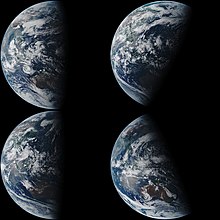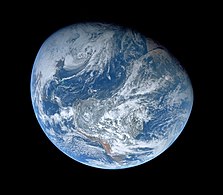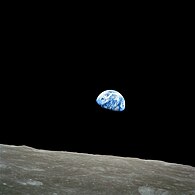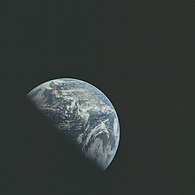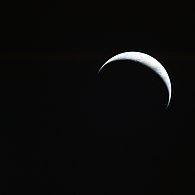
The full moon is the lunar phase when the Moon appears fully illuminated from Earth's perspective. This occurs when Earth is located between the Sun and the Moon. This means that the lunar hemisphere facing Earth—the near side—is completely sunlit and appears as an approximately circular disk. The full moon occurs roughly once a month.

A lunar eclipse is an astronomical event that occurs when the Moon moves into the Earth's shadow, causing the Moon to be darkened. Such an alignment occurs during an eclipse season, approximately every six months, during the full moon phase, when the Moon's orbital plane is closest to the plane of the Earth's orbit.

The Moon is Earth's only natural satellite. It orbits at an average distance of 384,400 km (238,900 mi), about 30 times Earth's diameter. The Moon always presents the same side to Earth, because gravitational pull has locked its rotation to the planet. This results in the lunar day of 29.5 Earth days matching the lunar month. The Moon's gravitational pull – and to a lesser extent the Sun's – are the main drivers of the tides.

A lunar phase or Moon phase is the apparent shape of the Moon's directly sunlit portion as viewed from the Earth. In common usage, the four major phases are the new moon, the first quarter, the full moon and the last quarter; the four minor phases are waxing crescent, waxing gibbous, waning gibbous, and waning crescent. A lunar month is the time between successive recurrences of the same phase: due to the eccentricity of the Moon's orbit, this duration is not perfectly constant but averages about 29.5 days.

A terminator or twilight zone is a moving line that divides the daylit side and the dark night side of a planetary body. The terminator is defined as the locus of points on a planet or moon where the line through the center of its parent star is tangent. An observer on the terminator of such an orbiting body with an atmosphere would experience twilight due to light scattering by particles in the gaseous layer.

Planetshine is the dim illumination, by sunlight reflected from a planet, of all or part of the otherwise dark side of any moon orbiting the body. Planetlight is the diffuse reflection of sunlight from a planet, whose albedo can be measured.

In astronomy, an extraterrestrial sky is a view of outer space from the surface of an astronomical body other than Earth.

The far side of the Moon is the lunar hemisphere that always faces away from Earth, opposite to the near side, because of synchronous rotation in the Moon's orbit. Compared to the near side, the far side's terrain is rugged, with a multitude of impact craters and relatively few flat and dark lunar maria ("seas"), giving it an appearance closer to other barren places in the Solar System such as Mercury and Callisto. It has one of the largest craters in the Solar System, the South Pole–Aitken basin. The hemisphere has sometimes been called the "dark side of the Moon", where "dark" means "unknown" instead of "lacking sunlight" – each side of the Moon experiences two weeks of sunlight while the opposite side experiences two weeks of night.

A planetary phase is a certain portion of a planet's area that reflects sunlight as viewed from a given vantage point, as well as the period of time during which it occurs. The phase is determined by the phase angle, which is the angle between the planet, the sun and the earth.
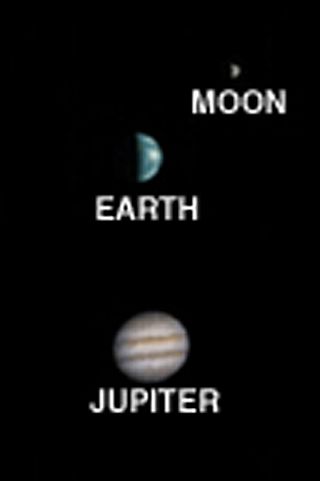
Many astronomical phenomena viewed from the planet Mars are the same as or similar to those seen from Earth; but some are quite different. For example, because the atmosphere of Mars does not contain an ozone layer, it is also possible to make UV observations from the surface of Mars.

The phases of Venus are the variations of lighting seen on the planet's surface, similar to lunar phases. The first recorded observations of them are thought to have been telescopic observations by Galileo Galilei in 1610. Although the extreme crescent phase of Venus has since been observed with the naked eye, there are no indisputable historical pre-telescopic records of it being described or known.

In observational astronomy, phase angle is the angle between the light incident onto an observed object and the light reflected from the object. In the context of astronomical observations, this is usually the angle Sun-object-observer.

The Moon orbits Earth in the prograde direction and completes one revolution relative to the Vernal Equinox and the stars in about 27.32 days and one revolution relative to the Sun in about 29.53 days. Earth and the Moon orbit about their barycentre, which lies about 4,670 km (2,900 mi) from Earth's centre, forming a satellite system called the Earth–Moon system. On average, the distance to the Moon is about 385,000 km (239,000 mi) from Earth's centre, which corresponds to about 60 Earth radii or 1.282 light-seconds.

Earthrise is a photograph of Earth and part of the Moon's surface that was taken from lunar orbit by astronaut William Anders on December 24, 1968, during the Apollo 8 mission. Nature photographer Galen Rowell described it as "the most influential environmental photograph ever taken".

The Moon is the largest natural satellite of and the closest major astronomical object to Earth. The Moon may be observed by using a variety of optical instruments, ranging from the naked eye to large telescopes. The Moon is the only celestial body upon which surface features can be discerned with the unaided eyes of most people.

Earthlight is the diffuse reflection of sunlight reflected from Earth's surface and clouds. Earthshine, also known as the Moon's ashen glow, is the dim illumination of the otherwise unilluminated portion of the Moon by this indirect sunlight. Earthlight on the Moon during the waxing crescent is called "the old Moon in the new Moon's arms", while that during the waning crescent is called "the new Moon in the old Moon's arms".
This glossary of astronomy is a list of definitions of terms and concepts relevant to astronomy and cosmology, their sub-disciplines, and related fields. Astronomy is concerned with the study of celestial objects and phenomena that originate outside the atmosphere of Earth. The field of astronomy features an extensive vocabulary and a significant amount of jargon.
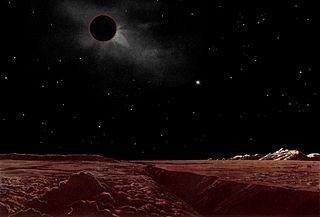
Solar eclipses on the Moon are caused when the planet Earth passes in front of the Sun and blocks its light. Viewers on Earth experience a lunar eclipse during a solar eclipse on the Moon.
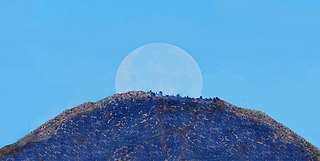
Moonrise and moonset are times when the upper limb of the Moon appears above the horizon and disappears below it, respectively. The exact times depend on the lunar phase and declination, as well as the observer's location. As viewed from outside the polar circles, the Moon, like all other celestial objects outside the circumpolar circle, rises from the eastern half of the horizon and sets into the western half due to Earth's rotation.

